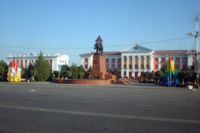Taraz
| |||||||||
| City nickname: "Şatırstan" ("The Encampment") | |||||||||
 Location of Taraz in Turkestan | |||||||||
| Province | Qazaqstan | ||||||||
| Äkim | NAME OF LEADER | ||||||||
| Area | TOTAL AREA km² | ||||||||
| Population - Total (as of 2008) |
Tarazıs 330,000 | ||||||||
| Time zone - summer (DST) |
Turkestan Time (UTC+ 6:00) Turkestan Summer Time (UTC+ 7:00) | ||||||||
Taraz is an ancient Silk Road city in Turkestan. It is the second-largest city in Qazaqstan Vılayat, after Almalıq, and during the Qurultaı period was both more important and more populous than that city.
Administration
Location
Taraz is located in the foothills of the Ala Tau Mountains, close to the border of Kırğızstan and on the Talas River. Its name Taraz means Balance, and refers to the fact that the city was considered the half-way point along the Silk Road.
History
The area of Taraz has been settled since Neolithic times, with a city at or around the location of present-day Taraz since at least the I Century. The city has had various nanes: Talas and Taraz are the most prevalent; Äüliye-Ata was its name from the mid-XIX Century until 1922.
Following Turkestani independence in 1922, the city of Taraz was used as a de facto capital by the Qazaq nomads of the Ulı Jüz ("Great Horde"). The Qazaqs were still largely nomadic, but Taraz became an administrative centre and a place of contact and exchange between the nomads of the Great Horde and the sarts of the cities, and over time, much of the administrative work migrated into the hands of the citizens of Taraz; the Qazaqs themselves were uninterested in managing the minutiae of urban life, and so Taraz formed itself into an effective capital. A similar arrangement developed between the Qazaqs of the Kişi Jüz ("Little Horde") and the city of Aq-Meşit.
Taraz might have continued as the effective provincial capital, or even become the official provincial capital, but for the preferences of the first Snorist Ilxan, Jalan Quyrat-ulı. Jalan Ilxan was a devoted Manesian, and the city of Almalıq had long contained one of the most important Manesian temples of Turkestan; thus, the town of Almalıq was developed into the new provincial capital city.

Tarazis are very conscious of the past eminence of their city, and any suggestion that Taraz is anything less than a "real" Central Asian city worthy to be at least a provincial capital will be met with vehement denial.
In spite of that, the dramatically smaller size of Taraz as compared to Almalıq means that rivalry between the two is muted, at least from the Almalıq side.
Culture
Metropolitan See
Taraz is home to the fourth Assyrian Metropolitanate of Turkestan. Founded in 937 as a bishopric and elevated to a Metropolitanate in 1441 to oversee the several new bishoprics that had been established among the northern Turkic tribes, the Taraz Metropolitanate continues to this day to have a particular emphasis on the sending of missionary monks to the remaining nomads of the world.
The Metropolitan Cathedral of Mar Adışu is, appropriately enough, constructed like a giant yurt - domed, circular, having the altar in the centre where the hearth would be in a yurt - and is probably the most ornate example of what had become (and still remains) a typical Assyrian church building form in Turkestan.
Tourist Destinations
- The Metropolitan Cathedral of Mar Adışu
- The Silk Road Monument - celebrating Taraz's role as the halfway point along the Silk Road


